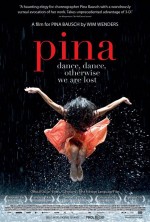Pina

First, we set the stage.
Pina Bausch was one of the giants of, not just German dance, but modern dance as a whole, helping to usher in the wave of dance theater — Tanztheater — into the modern dance oeuvre since the 1970s. Combining acting with intricate set design, score, and other hallmarks of what we would call a narrative theater experience, Bausch’s work seems a natural to entrance a venerable avant-garde director, someone with a firm understanding of how cinema works, who wants to push those boundaries, and who obviously prefers stories and ideas not normally part of the mainstream world.
Enter Wim Wenders (Wings of Desire), who has for several years been attempting to make a documentary of Bausch and her work. It’s the kind of thing which sounds like a perfect fit for the eclectic director, and it is, in every possible way. With the growth of 3-D technology, Wenders has tried several times to make a 3-D documentary, to push the technology away from gimmickry and towards an actual new form of cinema.
In Pina, he has found the theme to give voice to this form in his tribute to the choreographer and her work.
Cutting back and forth between dancers performing on the stage at the Tanztheater Wuppertal and performing the same works out of doors in diligently-chosen real-world locations (a train platform, a creek bed, etc.), Wenders has both turned Bausch’s choreography into cinema and captured its essence. Along the way he has endeavored, and largely succeeded, in actually putting the audience into the dance in the way a live audience never could be in some of the most beautiful 3-D photography of the year.
Next, we tear the stage down.
Bausch herself died shortly before Wenders’ film was set to begin shooting. So instead of a documentary about the woman and how she came to create what she did, Wenders has chosen to make a showcase of her art, instead.
And in the process, combining his 3-D cameras with a wealth of techniques — from old-school montage to modern tilt-shift lenses, in order to put the audience on the stage and outside and confound the senses in the process — he has taken her work apart to see how it works and affects us.
Throughout the four major stagings — and Pina is more of a dance exhibition film than what we would normally call a “documentary” — Wenders breaks his film down further with considerations and recollections from long-time members of Bausch’s company in a series of voiceovers and portraits.
That said, Pina still performs the task a good documentary sets out to: it illuminates its subject. Though we get only small snippets from the biography, history, and style of the woman herself, we get two full of hours of the real person in the form of her art. Wenders has taken the tack that in their creation, an artist is at their most naked, their most revealed. In that sense, Pina tells us more about the woman than any amount of conventional interviews ever could.
Which probably won’t make it any easier to sit through, for those used to more standard films, even among the documentary set. Though just two hours long, the performance-art nature of it all can make it seem to drag on, unless a viewer is willing to just surrender themselves to it rather than expecting something different out of it.
If you are willing, however, Pina is as rich in imagery and emotion as any film released this year — and in some cases, moreso. It pushes the boundaries of how to communicate these things to an audience and shows us what we could and should really be doing with 3-D, instead of Piranha remakes. Check it out; it’s worth it.
Cast: Pina Bausch as Herself; Regina Advento as Herself; Malou Airaudo as Herself; Ruth Amarante as Herself; Rainer Behr as Himself; Andrey Berezin as Himself; Damiano Ottavio Bigi as Himself; Bénédicte Billet as Herself; Ales Cucek as Himself; Clementine Deluy as Herself; Josephine Ann Endicott as Herself; Lutz Förster as Himself; Pablo Aran Gimeno as Himself; Mechthild Grossman as Herself.



Leave a Reply